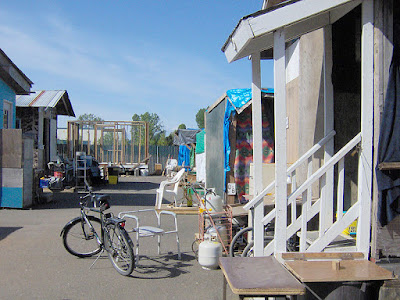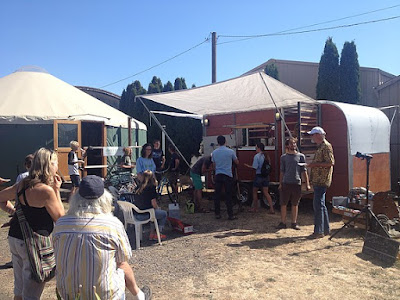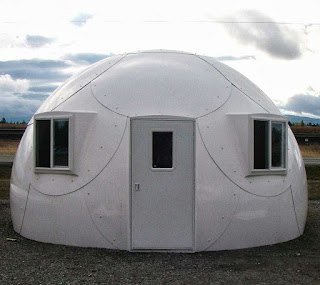Tactical Pop-Up Urbanism for the Homeless
Like many other cities, Baltimore has set a goal to end homelessness within 10 years. Baltimore will be near the end of this time-frame when yet another Mayor will be elected next year and there is no indication that homelessness in the city will end any time soon.
 |
| Homeless camp in Baltimore under the freeway ramps |
On any given night, at least 3,002 Baltimore city residents sleep on the streets, in shelters, in cars, or other such locations not meant to be home. Of these, four in five are African-American, two-thirds are men, and about half are between the ages of 36 and 50. The 2007 Homeless Census found that 1,000 Baltimoreans meet the federal definition of "chronically homeless," meaning they have been homeless for over one year or have had at least four episodes of homelessness in three years. (From the 2008 Baltimore plan)
It is estimated (source) that annually about 3.7 million Americans will experience homelessness. The goal to eradicate homelessness has proven to be elusive in every city that stated that goal. Is it for lack of trying hard enough or is it because the usual strategies of providing either more shelters or more affordable housing can't eliminate the problem altogether? Could it be that there is a need for a offering something that is much cheaper than regular affordable housing (of which there is certainly a huge shortage) and much better than the shelters of the current kind? If so what should such an additional offering be and how should it look?
 |
| Homeless in front of City Hall Baltimore (WBAL) |
 |
| Homeless in Baltimore |
Could there be a segment of the homeless who cannot or do not want to live in the street, but also not in shelters or multi-family dwellings? Could there be a segment of the homeless population that is not able or willing to settle into permanent quarters because of any number of circumstances, most of all a lack of money? S segment which would prefer transitional accommodation without too much paperwork, too many restrictions and obligations and for a very low cost?
This issue has been raised by the National Coalition of the Homeless in a 2010 regional study of "tent cities". Tent cities are attempts of a somewhat formalized and legitimate version of those random tent settlements (once during the Great Depression named Hoovervilles ) that are common in any larger US cities. City agencies, often with the help of police, dissolve the random encampments once in a while when either too many complaints get filed or the unsanitary filthy conditions can no longer be overlooked.
The legalized tent cities with names like Dignity Village (Portland, OR) are supposed to protect the homeless from losing their sparse possessions in those "clean-up" raids of unregulated encampments.The Portland Dignity Village was expelled from site after site until legal issues were settled and the city accepted a village on public land. Over 15 years that village has evolved from simply a mass of tents to a self governed place with wooden weather-sturdy structures. The National Coalition of the Homeless describes tent cities this way:
"Tent Cities are American's de facto waiting room for affordable and accessible housing. The idea of someone living in a tent (or other encampment) in this country says little about the decisions made by those who dwell within and so much more about our nation's inability to adequately respond to those in need." -Neil Donovan Executive Director National Coalition for the Homeless
Simple "tent city" for homeless
Others see tent cities or "tiny house villages" not only as a waiting room but as a stepping stone, a promising response to homelessness and self governance.
There is even a book titled "Tent City Urbanism: From Self-Organized Camps to Tiny House Villages," written by the trained planner Andrew Heben. From that perspective those safe villages are another aspect of tactical urbanism. A reviewer of the book concludes:
"Every town, city, suburb in America needs a place for our citizens to retreat to when the American Dream hasn't exactly worked out for them. This can happen to any of us. Imagine the least that would honor you as a human being until you're ready to plug in again. A place of refuge, to dry out, to learn work skills, and to get the confidence you need to succeed. Andrew's village model and this book will help you learn how to do just that."
Heben himself has engaged in the creation of tiny house villages and writes on his website about a recent visit to the Portland village which he describes as the original tiny house village. Code issues and camping regulations as well as fire inspectors need to be addressed:
Many buildings had added porches, bump-outs, or even a second-story. In terms of building inspections, DV primarily interacts with the fire marshal rather than the building department, and so fire safety is their primary concern. For example, the fire marshal has helped the village find a creative yet safe way of heating the dwellings with propane tanks outside of the house that pump heat in.(Heben)
If one could cautiously accept that such legitimate encampments serve a purpose, design of such accommodations becomes a veritable design challenge. The design of a type accommodation that responds to the desire of mobility, independence, self governance, safety and extremely low cost involves all the usual challenges associated with architecture and urbanism.
 |
| Tiny House "Dignity Village" Portland, OR (Photo A. Heben) |
The question of how good design can support human decency is central and legitimate and part of the design of schools, hospitals, prisons, affordable housing and just about anything in between. Rightly so. Architects are supposed to contribute the skill of making places and spaces feel comfortable and humane, a task that is more complex than just making things pretty. Should the design of tiny houses or the layout of tiny house villages such as the one in Oregon be addressed by architects and planners or would it defeat the whole purpose of self governance to do so?
A book that was popular in the time of the youth revolt of the sixties: Architecture without architects, addresses that question also. It had been become a cult book of those who tried to find independence in hippie settlements. Originally an exhibit the book illustrated that historically some of the most beautiful human
 |
| 1967 book Architecture without Architects |
settlements on Greek islands or in southern Italy (the hill towns, for example) or in South America where created without blue-prints, constructed by the people for the people with little to go by then local tradition and materials. Looking at the wonderful images from African villages to the settlements of American Native Indians the question whether people can create better architecture than architects was inevitable.
 |
| Square One village, Eugene OR (photo:A. Heben) |
It seems prudent to engage the highest level of caution when architects address social problems such as homelessness. Homelessness is a complex problem and not chiefly one of design. Haven't architects dropped well intentioned solutions onto too many situations without the vetting, investigation and involvement of those who are supposed to benefit from the design?
All this should not discredit architects in general from trying to make contributions to issues that are foremost social in nature. Auburn's well known Rural Studio is a good example for how things can be done for a low cost and with proven public benefit. Even the case of the Rural Studio, though, raises sometimes eyebrows and critique of "elitist architects" as if design and basic needs were mutually exclusive.
The issue of engaging design professionals also comes up in the context of the European refugee crisis. Cities have to deal with tens of thousands of refugees that need accommodation quick. Gradual self-governed development of a village like the one in Portland isn't even an option, let alone the construction of regular affordable multi-family housing. Neither can be created fast enough to keep pace with the stream of refugees. On the other hand,accommodation in camps stamped out by government, nonprofit relief agencies or even the military often results in squalid inhumane accommodations that defy human dignity with their total lack of consideration for design or place. Some architects have stepped up with their ability of creating recognizable and more pleasant spaces by considering design beyond the military way of creating rows of tents, containers or barracks which are so characteristic to refugee camps and been praised in an article in the German weekly Der SPIEGEL).
 |
| Designer idea for the homeless cart/tent |
In the US, as well, there is no shortage of ideas for homeless or refugee accommodations, but many overlook the main points that the "Dignity Villages" addressed, chiefly the aspect of safety and legitimacy.
Andrew Heben advocates that cities with policies for the homeless should offer legalized spaces that allow homeless some say in how they are organized so that such small settlements could be better than tent encampments yet not as permanent and expensive as "social housing". Such approaches are still rare. As noted, they require extensive re-thinking of current policies including re-writes of applicable codes and regulations.
A review of published ideas on how design can assist the homeless, shows many concepts that focus on the design of the shelter unit itself such as the design of a tent that can also be a cart. Those approaches are not only suspect for making the homeless even more visible, they necessarily leave out the most important aspects, namely social interaction, security, services and the issue of making the use of the shelter legitimate.
By contrast, Heben's tiny house villages show house designs that aspire to a standard traditional idea of what a house is, albeit on a much smaller scale. With some help users can erect the structures themselves.
 |
| Erection of a tiny house from a kit designed by A. Heben is simple and can be done mostly by residents themselves. (Photo A. Heben) |
Moreover, the village concept approaches the problem on many levels at once. The village is on a legitimate ground ("a small gated community of sorts"), it offers some central services for cooking, sanitary facilities or meeting spaces reminiscent of campgrounds. Arranging the individual shelters in a way that simulates a village with streets and plazas introduces elements of urbanism and urban design.
Most importantly, about 50 homes of a village combined still cost less than a single HUD conforming "affordable apartment." According to the church that operates one of the villages, the units without their own water and electricity can be operated for as little as $3 a day, a tiny fraction of what it costs to pay utilities in even the most affordable standard dwelling unit, mobile homes included.
In their design and arrangement the tiny house villages don't superimpose design in an essentially useless manner, but let it cater to the traditional yearnings of humans leading to arrangements that have become archetypes for millennia, whether in the Italian Trulli settlements of roundhouses in the La Puglia region, tent cities of Native Americans or hut villages in many regions of Africa.
The range of images for temporary accommodation shown here, will provoke reactions ranging from "what were they thinking?" to "oh this looks almost cozy". Some ideas appear condescending and cynical, some eminently practical. Regardless, not thinking about the homeless at all (except for Thanksgiving and Christmas and then mostly in the context of food) is probably more cynical than creating misguided design concepts.
 |
| Design idea temporary shelter (Photo: Intershelter) |
Germany will present shelter ideas as its national contribution for the next Architecture Biennale in Venice, the rather blusterous international design affairs with more champagne than social concern. The highest alert level may once again be appropriate, but that the Biennale even makes the homeless a topic could be chalked up as some sort of progress. Design is also an art form and must allow experimentation.
Design for the homeless, then, should be considered as an attempt to respond with design solutions to the diversity of the contemporary urban population. Design for the basic accommodation of people must recognize that the diversity range is much wider than the prevailing rather uniform design of homes, apartments and condos would suggest. Design must accept that there is no consensus about what idea of " home" is right. Increasingly, there is also no common base for what is achievable and affordable.
Klaus Philipsen, FAIA
 |
| Hanging from a building wall: British architect designs sleeping pod |
Next week's blog article will take a deeper look at the state of affordable housing in America
Tent Cities in America's Pacific Coast Report (The National Coalition for the Homeless)
Philadelphia students design homeless shelters in Haiti.
German artist designs for homeless and Urban Nomads
One Architect Has a Brilliant Solution For Getting Homeless People Off the Streets
Housing for the Homeless: 14 Smart & Sensitive Solutions
Tent Cities: A Safe Haven for Homeless Across America
U.S. Cities Criminalize Homelessness, Violate Human Rights Agreements
The Secluded Homeless Camps of Baltimore
PBS Video about the Tiny House Villages
Sanctioned "Tent Cities" per tentcityurbanism.com:
Tent City 3 - Seattle, WA (2001) - 100 residents / Itinerant
Tent City 4 - Seattle, WA (2004) - 100 residents / Itinerant
Pinellas Hope - St. Petersburg, FL (2007) - 250 residents / Private Land
Camp Quixote - Olympia, WA (2007-2013) - 30 residents / Itinerant
Camp Hope - La Cruces, NM (2011) - 50 residents / Private Land
 |
| Unsanctioned "tiny house" |
- Article 1: "A View of Dignity Village"
- Article 2: "Portland's Dignity Village: Thirteen Years Later"
OPPORTUNITY VILLAGE - Eugene, OR (website)
- Sanctioned 2013 / City-owned Land / 30 units
- Article 1: "Opportunity Village: Up and Running"
- Article 2: "Development at Opportunity Village"
- Article 3: "Opportunity Village as a place for pooling and mobilizing local resources PART I"
- Article 4: "Opportunity Village as a place for pooling and mobilizing local resources PART II"
QUIXOTE VILLAGE - Olympia, WA (website)
| Dignity Village, Portland OR (photo: A Heben) |
- Sanctioned 2013 / County-owned land / 30 units
- Article 1: "Quixote Village in Olympia, WA"
- Article 2: "Quixote "Village: The High Cost of Federal Funding"
SECOND WIND COTTAGES - Ithaca, NY (website)
- Sanctioned 2013 / Private Land / 18 units (Development Stage)
OM VILLAGE - Madison, WI (website)
- Sanctioned 2014 / Private Land / 9 units (Development Stage)
- Article 1: "Occupy Madison Build"
- Sanctioned 2014 / Private Land / 200 units (Development Stage)
- Article 1: The Details on Austin's 200-unit Micro-Housing Community
 |
| Sleepbox by ArchGroup (Russia) |
Manifest Destiny: A Guide to the Essential Indifference of American Suburban Housing

